In this post, I’m going to talk about learning to jump on a horse during English horseback riding.
More specifically, I’m going to tell you how to position yourself and how you want to actually execute a jump in English horseback riding.
So during showjumping you’re not going to progress to very high jumps right away. You’re going to start with lower jumps and actually, you’re probably going to start with polls.
Then you’ll progress to low jumps like cross rails, and on towards higher, parallel jumps. Even further on, you’ll go across the higher jumps, oxers and the like.
I won’t just talk about the physical aspect (what you need to be doing with your body) but also the mental aspect. All of this is hopefully going to prepare you for jumping and reduce risk of your horse rejecting the jump. Together we’ll by make sure that your horse is properly set up for the jump and that you’re more confident of yourself going into it.
Polls to Small Jumps – Eyes & Two Point
Okay. The first thing I want to talk about is starting from scratch when you’re learning to jump on a horse. I’ll start with preparing for polls, and then I’ll talk about when you’re preparing for small jumps.
When you’re preparing for polls, you need to make sure that you can do polls in a two point. This is going to prepare you to do a low jump.
Where to Look
First thing is where your eyes are – always keep your eyes up and on where you are going.
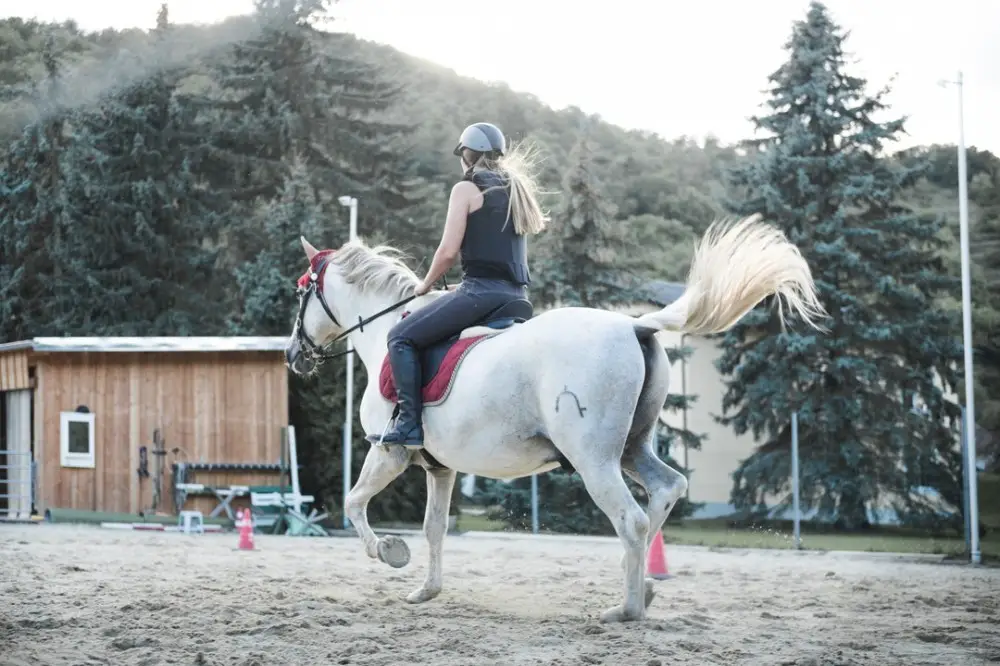
When you’re doing a two point and heading towards the polls, you never want to look down at the polls.
When you’re turning towards your polls, just prior to being aligned with them, you want to look at them. This is because you want to be looking towards the general direction that you want your horse to turn.
Then, once you’re in line with the polls and centered, you don’t want to be looking down anymore. You want to look at the far end of the ring where you’re heading. Keep your eyes directly in front of you. If the polls are at the far end of the arena then you might want to start turning your head as you near the end.
But when you’re just learning to jump on a horse, I recommend you keep your eyes on the far wall until you’re clear of the polls, just focusing on your two point position. Once you’re clear of them, get back into your sitting trot or your posting position. Then immediately look which way you want your horse to turn on the far side.
Posture
During the polls in your two point, keep your posture high and your weight down in your heels.
When you’re getting in your two point position, make sure that your legs are tight and your bum is tight. Everything should be tight, but still loose enough that you’re moving with your horse, okay?
You also want to make sure that your weight is firmly in your heels. The ball of your foot should be tightly snug within the stirrups. You probably have a feel for this already if you’ve been riding for a little bit.

There’s this position that your legs get in where they’re nicely hugging the belly of your horse, your heels are pressed down nice and low and you generally feel stable and in tune with your horse. This is how you want to be in your two point position. Your knees should be squeezing and hugging your horse. And you should only come out of the saddle slightly when you’re doing polls.
Generally, you’re not going to be doing your very high drums for a while. So you don’t need to have a major two point. It doesn’t need to be extreme. Your bum doesn’t need to be all the way out of the saddle and your entire body shouldn’t be leaned over your horse’s neck. If you do this kind of extreme position, you’re putting yourself at risk for falling forward over your horse’s neck. Imagine if your horse decides to reject the jump, shy away from the jump or move unexpectedly in any way.
Don’t worry, you’ll 100% get there. But for now, just a little two point is perfect. You’ll impress your coach by just coming out of the saddle a bit.
Being so far forward is not a stable position. A stable position is if you’re slightly out of the saddle so your weight is back and way down in your heels. The idea behind a two point is that you’re getting your weight off of the back of your horse. This will let your horse jump properly.
What to Do with Your Reins
Now, let’s talk about reins. I would really recommend that as you’re starting out learning to jump on a horse that as well as gripping the reins you also grip some of your horse’s mane. I know professional jumpers that still do this. There is no harm when you’re going over a jump to grip your horse’s mane a little bit.
That way, if your horse shies away for any reason or if your horse decides to do anything weird, it prevents you from pulling on your horse’s mouth to stabilize yourself.
It’s way better if you have a little bit of their mane instead of pulling on their mouth. This will help anything goes sideways or even if you just feel a little shaky during the jump. It doesn’t hurt your horse to pull on their mane, but it will hurt to pull on their bit. You might also accidentally give them a mixed signal to turn in a way you don’t want them to or stop suddenly.
Since you’re just starting, you’re going to be a little bit shaky and that’s 100% okay. So just grab some mane to help you out with your two point and try to focus on balancing and posture.
Polls to Small Jumps – Body Positioning & Stability
So now we’re going to talk a bit more about positioning and stability.
As I said, you want to be looking straight forward over the polls / small jump as you’re coming at it. You want to feel as stable and a secure in your position as possible. Then when you’re actually going over the polls, you want to let your body just relax slightly.
Going up to the jump, you want to be tight, but not so tight that you’re bouncing with your horse’s movement. You still need to move with your horse, but you do want to have a sense of tightness especially around your horse’s belly as you’re coming towards the polls.
The reasoning is that you want to be very controlled, but without sacrificing your balance or positioning.
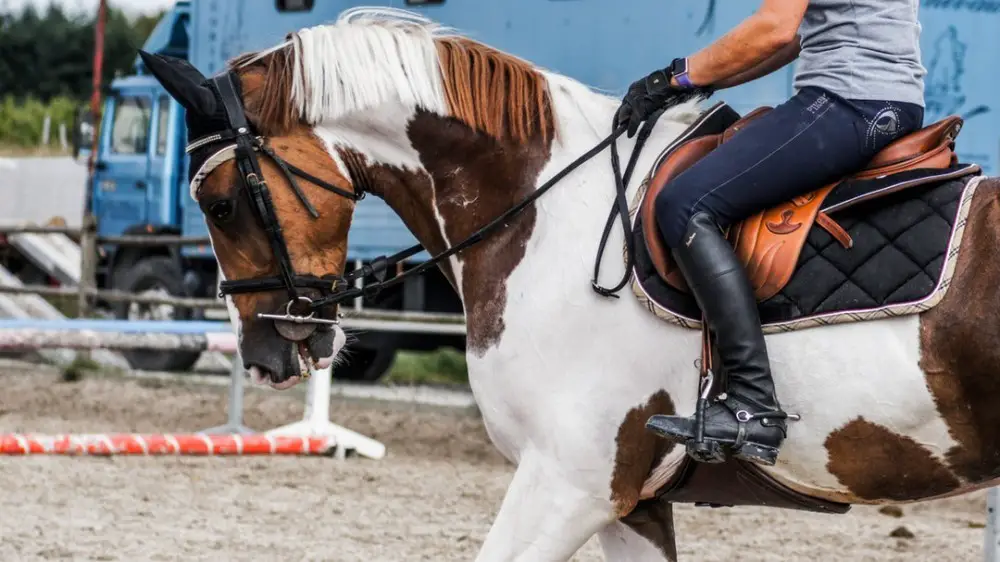
For beginners, it’s important for you to keep your position as steady as possible going up into jump. This will keep you feeling ready and confident. When you start losing your balance, you lose confidence. Your horse can feel that and is much more likely to reject the jump.
Also, if you’re moving around too much in the saddle, your horse isn’t going to want to try and jump over something.
The Jump Itself
So, you’re in the right position and you’re nice and stable. Then you actually get to the polls or jump. Once you start going over, you’ll notice that you have to loosen up the slightest bit to allow your body to follow your horse’s lead.
What I like to say is that it’s your job to get your horse to the jump in the best position possible and set everything up as best you can. That’s 100% your job. But then you’ve got to put the faith and trust in your horse and let them do the rest. If you have faith in your horse, they won’t let you down. But it’s that few seconds of doubt that usually leads to a rejected jump.
So just put in 100% getting your position and alignment right. Then keep your eyes up, get in your two point and keep your weight down in your heels. Finally just relax the tiniest bit so you can follow your horse’s lead over the jump.
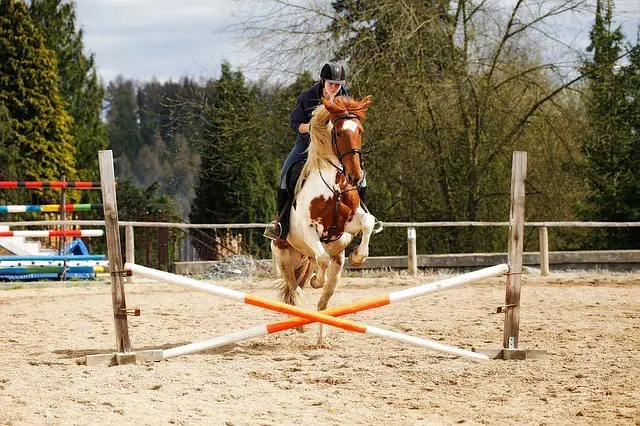
Keeping that in mind, if you don’t do something quite right, don’t sweat it. If you’ve got a forgiving, well-trained horse then your horse can usually make up for it.
If there is a little bit of a last minute correction, that’s also going to be a little bit bumpy. Especially going over the polls, your horse is going to bounce. So again, just make sure you’re relaxed enough to follow this movement.
Not so relaxed, obviously, that you’re flopping all over the place. You still want to be controlled, particularly by keeping your hands in a controlled position. That said, you also don’t want to be super rigid. If you’re super rigid, your feet are going to come out of the stirrups or you’ll bounce around.
Once your horse has accomplished the jump, then you can go back to a little bit more of a tighter controlled posture.
All right, so I think we’ve covered most of the steps!
Higher Crossrails & Parallel Jumps
Once you’re moving onto learning to jump on a horse doing bigger jumps, the whole process is pretty similar. The only difference is how much you have to adjust your two point and how confident you are and your horse is. The higher the jump, the more important it is to get your horse in the right position.
As you start doing courses, you also have to start controlling your horse’s pace. This will help to make sure they have enough room coming up towards the jump. That’s a little too advanced for this article – let me know in the comments if you’d like me to write a separate piece on that!
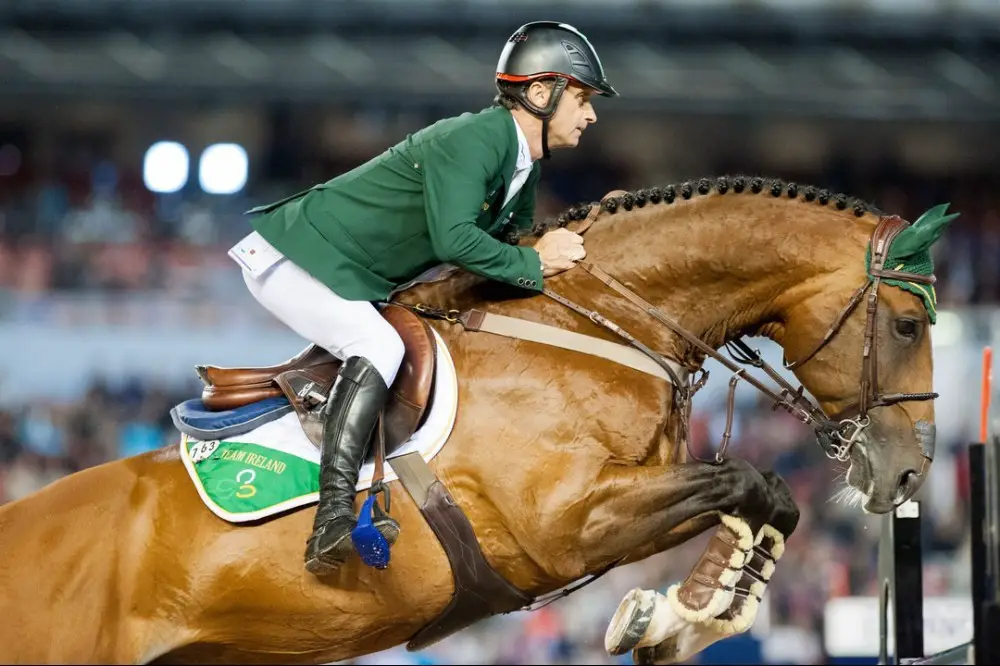
One thing I will mention that you may want to start working on now is signalling to your horse as you’re jumping. That way they can break into the correct canter lead when they land. This is a little bit more advanced, I would say, and you’re probably staying mostly in trots for the moment. When you’re getting into jumps that are a bit higher and your horse starts breaking out of them in a canter, then I would suggest starting to practice this.
When you’re doing courses later on, you want to be able to tell them which lead they have to break into. Sometimes it’s going to be going left and sometimes right, depending on how the course is setup.
Think of it as an advanced addition that will help you as you start to get better and more advanced.
I find that it’s annoying to learning to jump on a horse a certain way, and then all of a sudden you’re trying to handle this big jump, with all of the confidence that entails while also having to worry about which lead you’re telling the horse to go. I was in the habit of always asking for a right lead without even realizing because of the way I was setting up practice jumps.
Something that will make a huge difference is after you land, start looking in the direction that you want to go. That will help your body signal to your horse which lead is the right one.
All you need to know for now is that higher jumps will come a lot faster. But they’ll be a lot easier if you master learning to jump on a horse with small jumps first, because you’re letting your horse do the jumping part. If your horse can do it, so can you.
Your job is getting your horse to that jump in the right position and keeping yourself stable so your horse feels safe jumping. And that part is the same no matter what the jump is 🙂
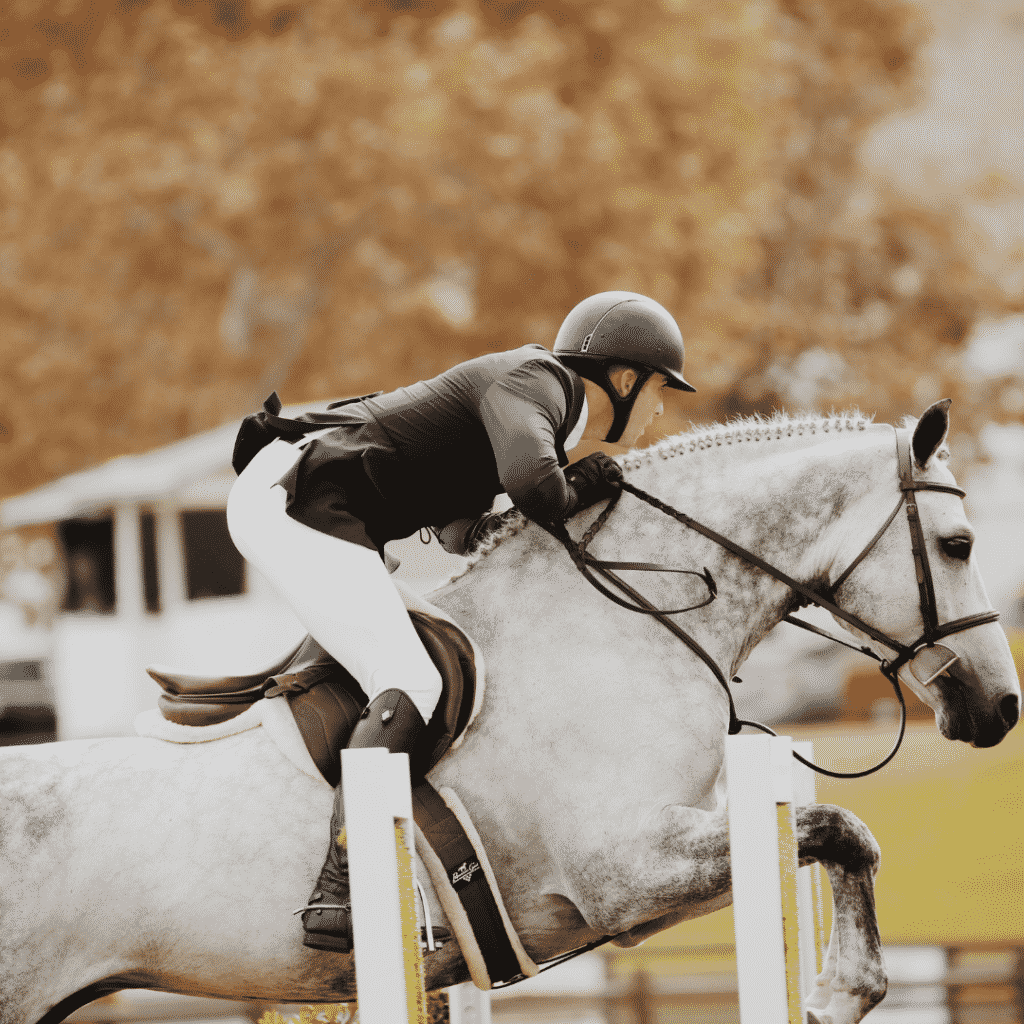
Notes to Keep in Mind
- Some horses will overjump little jumps. Be prepared by relaxing slightly and staying ready so you can move with your horse no matter where they go.
- In contrast, some horses will under jump a small jump. They’re like “Oh, this is nothing, I don’t even need to really jump” and then they kinda stumble over it. For these horses, you have to keep the leg on for them going up to the jump so they work a little harder.
- If your horse rejects a jump, you’re most likely to fall off forward from the inertia. Don’t overdo your two point, rise up into it as your horse starts to jump and always keep your weight in your heels rather than letting it come forward. A great tip is that you should feel a stretch in your hamstrings at the back of your legs when you’re putting your weight in your heels and coming up into a two point.
- Horses may trot up to a jump and then canter out of it which is totally fine. Just be prepared for this, and make sure you don’t let your horse run away from you after a jump. You only want to relax for that brief period where they’re jumping but afterwards you have to regain control.
Do your Job and Let your Horse Do theirs
Okay, well I know that was a lot of information!
The main points that I want you to take away about learning to jump on a horse are:
- Keep your weight in your heels and your eyes where you’re going. If you need help keeping your heels down, have a read of my guide to ankle mobility!
- Your job is getting your horse to the jump and your horse’s job is to do the jumping.
- The more you perfect your ability to jump small jumps initially, the easier it will be for you to jump virtually any height down the line.
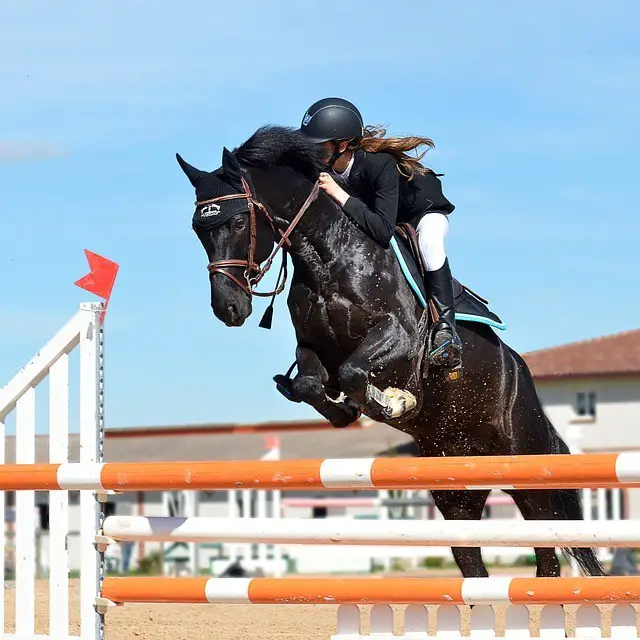
Now that you understand the basics, have a read on minimizing fall risk while mastering jumping.
I hope that it was useful for you and just let me know below if you have any questions. I’m super happy to answer them!
Happy riding,
Martina
Liked this post? Why not pin it!
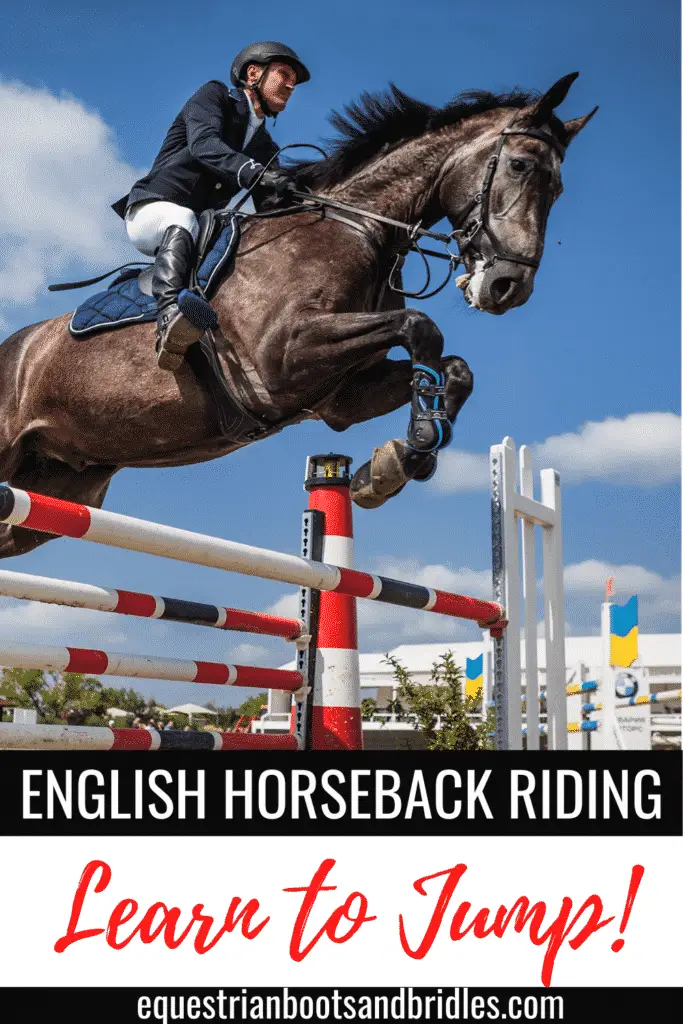

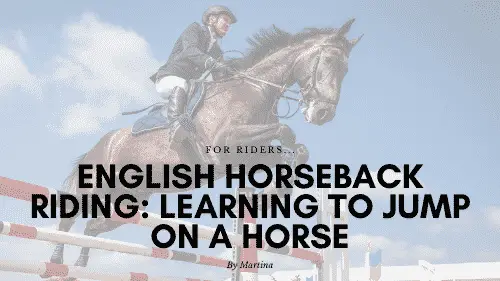
Hi Martina, you offer a lot of good advice from start to finish for people who are just starting off jumping with their horse.
I have always loved horses and always wanted my own when I was younger but that was never going to happen. I used to go to a riding school on a Saturday morning and loved it but never ever got round to doing any jumping – I’m hoping to actually get into it again which is how I stumbled across this post.
Also, I love to watch is the Horse of the Year show, especially the horse jumping and the dressage.
Hey Cheryl,
So happy you’re thinking of picking up riding again! Its great for a whole host of reasons – I actually wrote a post about it haha
Let me know if you need any other help 🙂
Cheers,
Martina
My father was a Jockey so I have lots of experience with horses and absolutely love them. I just finished reading your article on English Horseback Riding: Learning to Jump on a Horse. My daughter is a great rider and has an interest in Equestrian riding. We wanted her to be a Jockey like her grandpa but her decision is hers to make. I saved your article for her to read and saved your website to my favorites. Thanks for a great article.
Jack
Hey Jack,
That’s incredible! I’m not too familiar with horse racing myself – I’m more on the side with your daughter into English and Western riding, especially showjumping. If she’s already jumping, it may be a little bit basic for her but if she skims through it, there are some more advanced points I throw in here and there 🙂
Cheers,
Martina
Great tips and training on learning how to jump on a horse. I will try this from a-z. I believe in your words and can tell you are confident that this will work. From what you’ve said, I have to be confident too. I will maintain control of the horse during and after the jump. Thanks for all of your help.
Hey Jonathan, Glad to be of service, feel free to let me know how it goes 🙂
Hey girl,
You did a fantastic job on this article. It was thorough and I could really see myself doing it! Your instructions were clear and concise. It was very easy to tell you have a distinct connection with horses. I wanted to be an Equine Psychotherapist, but I was already to old to begin my training. That’s for the young pups. I think you are on the right track, don’t lose sight of your dream. Great job!
Hey Rae,
Thanks girl! Taking it one day at a time haha – appreciate the support 🙂
Cheers,
Martina
Hi Martina,
Your article has brought back so many happy memories as I grew up in a riding school. Many of our students were recruited to the Sydney mounted police from our academy. Sadly I was too short.
I have younger girlfriends who are still very active in eventing and western as we all have farms out this way. They sent me a youtube link called “Dressage meets Cowboy”. I wish I could give you the link as I am sure you would have enjoyed it as much as I did.
I do have a question. At what point when your horse is airborne do you signal a change of lead at the canter?
I am looking forward to your reply.
Kind regards
Coucka
Hi Karen, Awww I’m so happy to hear that! Do you still ride at all? As soon as I’m jumping I’m looking in the right direction and positioning my body. Right as I’m about to land is when I usually start giving the signal and then really squeeze as we’re landing. Usually looking in the right direction and positioning your body will be enough for a horse you have a great connection with but some horses will need more of a queue 🙂 Hope that helps!
Warmly,
Martina
Hi Martina,
Thanks for that eye opening post. I didn’t know that horseback riding has so much to learn about! I usually admire how that horses have such a huge and interesting history in battles and as a sport.
For a green beginner who would be very far away from even attempting a jump, what breeds would you recommend for them to start with as they develop the skills to professional horseback racing?
Hey there,
It’s not so much about the breed as it’s about how to horse is raised and their disposition. Look for a barn nearby with some docile trail horses to start off with 🙂